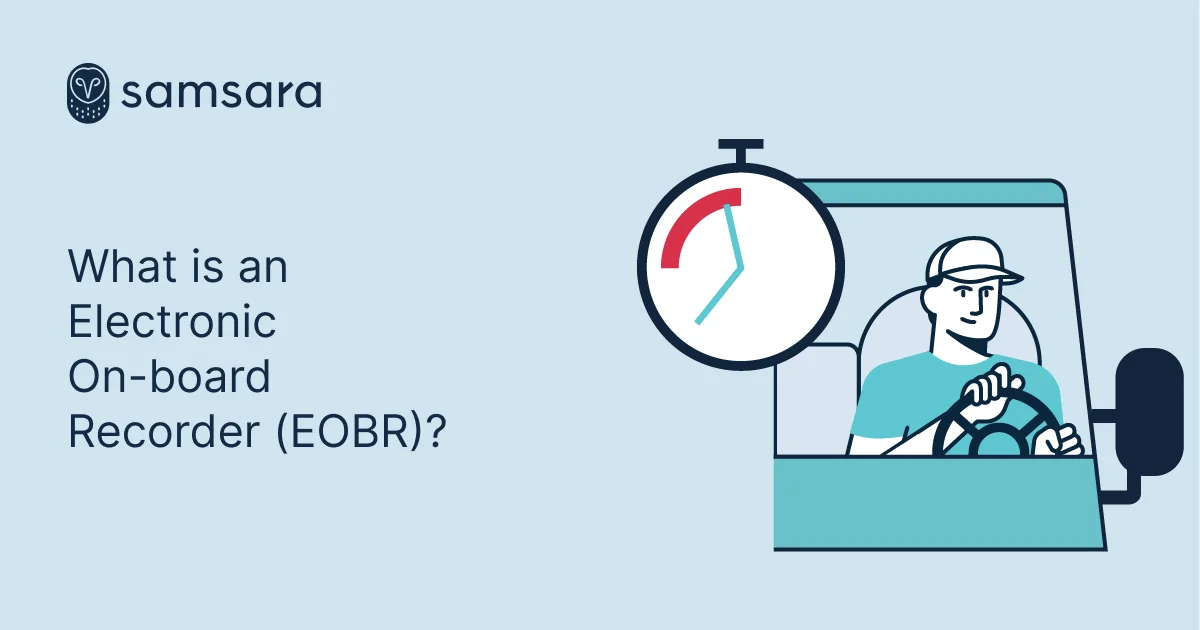What is an Electronic On-Board Recorder (EOBR)?
October 22, 2021

Get Started with Samsara
Check our pricesKey Takeaways
Electronic on-board recorders (EOBR) were used to monitor when fleet vehicles were moving and recorded driving time. One of the early digital recorders, EOBRs helped replace paper logbooks, enabling truck drivers to record their hours of service digitally. Learn more about how the ELD Mandate affected use of EOBRs.
What is an electronic on-board recorder (EOBR)?
An electronic on-board recorder (EOBR) is a cab-mounted device used in fleet management to record the length of time vehicles are driven. EOBRs can monitor when vehicles are moving , making them more accurate than traditional paper log books. EOBRs are the American equivalent to the digital tachograph, which is used in Europe.
How the ELD Mandate affects EOBR
EOBRs have been around since the 2000s, enabling truck drivers to record their hours of service (HOS) digitally instead of with paper logs. In 2007, the Federal Motor Carrier Safety Administration (FMCSA) attempted to make EOBRs mandatory for carriers with a history of HOS violations. Renewed proposals for general EOBR usage resurfaced again in 2012, but it wasn’t until 2015 that a proposal went into effect.
In December 2015, the FMCSA announced the ELD Mandate or ELD final rule. The mandate created a new term for HOS recording devices called “electronic logging devices” or ELD. It also required commercial drivers to use an ELD to track their HOS, replacing EOBR.
The FMCSA instituted a phased approach to ELD implementation. Fleets using paper logs had until December 18, 2017, to install a certified ELD to record HOS.
Fleets already equipped with electronic logging technology had a longer reprieve. They had until December 16, 2019, to make the switch. Any vehicle previously equipped with an EOBR or AORBDs had to replace or upgrade their device to meet the ELD requirements.
Difference between AOBRDs, EOBR, and ELDs
There are many acronyms for devices commercial drivers use to maintain HOS records. While these devices are all recorders, the FMCSA has issued specific guidelines to differentiate between devices.
AOBRDs
AOBRD stands for Automatic On-board Recording Device. It is an electronic or mechanical device used to record a driver's duty status information accurately and automatically as required by Department of Transportation (DOT) regulations. Generally, AOBRDs do not automatically record vehicle location and have less restrictive hardware than ELDs.
EOBRs
While both EOBRs and ELDs track a wide variety of metrics, ELDs have specific technology requirements outlined by the FMCSA. (See below) As of 2015, the term EOBR has been replaced with ELD.
ELDs
An electronic logging device (ELD) is hardware used to record driving time for commercial motor vehicles. ELDs plug into a vehicle’s on-board diagnostics (OBD) port to capture data on the vehicle’s engine, location, speed, miles driven, and more.
The ELD mandate lists technical specifications that ELDs must meet to be self-certified and registered with FMCSA. (The FMCSA doesn’t approve devices themselves. ELD providers self-certify and register the devices with the FMCSA.) For example, compliant ELDs must:
Have standardized data that follows a specified format
Be able to transition data via USB, Bluetooth 2.0 or wirelessly
Allows a driver to change their driving status (on-duty, off-duty, or on-duty without driving)
Pull data diagnostics from the vehicle’s engine control module.
Show drivers their records of duty status (RODs) for tracking purposes
The rules surrounding ELDs are more detailed but assist in the effective enforcement of hours-of-service (HOS) regulations, bringing accountability and increased safety to the trucking industry.